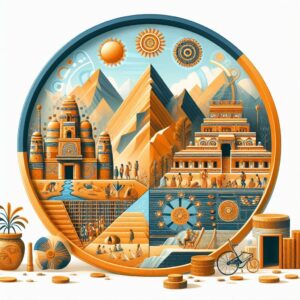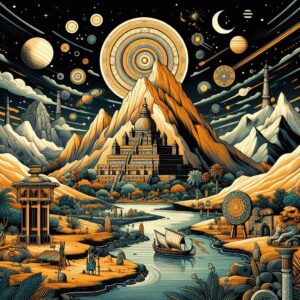John Marshall, the Director General of the Indian Archaeological Survey of India, named this civilization as Indus Valley Civilization because initially the sites were found on the banks of the Indus and its tributaries, but later the sites of this civilization were found in Southern India, where Indus or its tributaries do not flow. In such a situation, the entire civilization was named Harappan Civilization after the name of the first excavation site, Harappa.

This civilization is a civilization of the prehistoric period, i.e., its written evidence is available, but it has not been read till date. This civilization was a Bronze Age civilization, meaning that people here knew how to make bronze metal by mixing 90% copper and 10% tin. However, copper metal was used more. Gardenchild named this civilization ‘urban revolution’ Charge Mason was removed in 1826. In 1842, he wrote an article (Narrative of Various Journeys) in which he said that Harappa was the city where the war between Alexander and Porus took place in 325 BC. Cunningham also visited Harappa several times during 1853-56. He wrote that the city of Harappa was founded by Alexander. During the construction of the railway in Sindh province in 1919-20, houses made of bricks were found. After this, the British government gave the responsibility of excavating this civilization to John Marshall. Under the leadership of Marshall, Dayaram Sahni excavated the city of Harpiya in 1921 and Rakhal Das Banerjee excavated the city of Mohenjodaro in 1922. John Marshall went to London and on 20 Sept 1924, in a newspaper called The Illustrated London News, he announced with a picture of the city of Mohenjodaro that we have found a civilization 3-4 thousand years old from India. However foreign historians refused to accept that this is India’s own civilization.
Theory of Foreign Origin
According to John Marshall, Martiner Wheeler, D.D. Kausambi etc., the Harappan civilization was a colony of the Mesopotamian civilization of Iraq. Many similarities have been found between the two civilizations
- Both civilizations were located on the banks of rivers. Mesopotamia was located on the banks of the Tigris and Faran rivers while Harappan civilization was located on the banks of the Indus and its tributaries.
- Granaries have been found in both civilizations.
- People of both civilizations were familiar with agriculture, had knowledge of the script, seals have been found in both civilizations, religion was prevalent and
- People of both civilizations did not have knowledge of iron.

Inequalities Between Mesopotamia & Harappa
| Mesopotamia | Harappa |
| 1. Rural civilization 2. Agriculture based economy 3. There was a monarchy 4. The priestly class was dominant 5. The roads lacked drains 6. Houses were made of unbaked bricks 7. Private Granary 8. Cylindrical Pieces 9. The cuneiform script was 10. Evidence obtained from religious places | 1. Urban civilization 2. Commerce based economy 3. There was democracy 4. The merchant class was dominant 5. There was a proper drainage system in the road 6. House made of baked bricks 7. Community Granary 8. Square and rectangular pieces 9. Bhava pictographic script 10. No such witness was found |
In the trade between the two civilizations, the residents of Harappa exported grains and cotton and imported precious stones. Harappa civilization used to get more profit in the trade. Harappa civilization was a more developed civilization than Mesopotamia. No colony can be more developed than its own country. The opinion of Amalananda Ghosh is most accepted that this was India’s own civilization.
Status and Extent
The sites of this civilization have been found in Afghanistan, Pakistan, and India. About 2000 sites have been discovered and most of the sites have been found in Gujarat. The shape of the civilization was triangular or trapezoidal. Initially, the total area of the civilization was 1299600 sq km. At present many sites have been discovered and hence the area has become 15 lakh sq km.

At the time of partition, only two parts of this civilization were in India – 1. Rangpur (Gujarat): on the banks of the Madar River 2. Kotla Nihang (Punjab): On the banks of the Sutlej River
- In the north – Manda (J&K) – Chenab river
- In the west – Sutkagendor (Baluchistan-Pak) – Dwashk River
- To the east – Alamgirpur (UA) – not Hindon
- In the south – Daimabad (Maharashtra) – Pravara river
This civilization was 1600 km long from east to west and 1400 km long from north to south. Mundigal and Shortaghui were places located in Afghanistan. Shortaghui is considered to be the uppermost end. The highest concentration of civilization was on the banks of the Saraswati and Hakra rivers.
Features
1. City Building Plan
This is the most important feature of civilization. The cities were divided into two parts: the fort in the west and the settlement in the east
- Western Fort: It was smaller than the settlement and was built on a raised earthen mound. For security purposes, a brick wall was built around the fort. The fort was home to the warriors and priests.
- Eastern settlement: It was inhabited by labourers, farmers, craftsmen and traders.
But this common characteristic was not found in some cities:
- Kalivanga (Hanumangarh): In this, apart from the fort, a brick wall was built around the settlement
- Chanhudaro (Pak.) – There was no fort situated here, there was only a settlement.
- Lothal and Gurkotda (Gujarat): There was no division of the city. The fort and the settlement were connected to each other and there was a single rectangular wall around it.
- Dholavira (Gujarat): This city was divided into three parts.
- Sutkangendor (Baluchistan): The fort of this city was built on a natural rock of stone. There is a stone wall all around and carvings have been done on the wall.
The cemetery to the south of the settlement has been found at all the places except Mohenjodaro
2. Building Construction
- The houses were built using the English Bond method. This gives strength to the building’s construction.
- The houses were made of baked bricks which were baked in fire. The houses of Kalibanga were made of unbaked bricks which were baked only with sunlight. The bricks obtained from Kalibanga are called Suryataapi.
- The size of the bricks was 4:2:1 (length nine height).
- The floors of the houses were made of unbaked bricks; only in Kalibangan, there is evidence of the floor of a house being paved with ornamented intersecting circular terracotta tiles.
- Residents of Kalibanga use wooden beams in the construction of the roof of their houses.
- The roads were based on the Oxford pattern, that is, there was one main road and the other roads were connected to it at right angles. However, in Banawali (Haryana), zigzag (star-shaped) roads have been found.
- The drainage system was found from all the sites but in Banwali, the drainage system was found to be completely absent. Drains were made of unbaked bricks and bituminous and gypsum were added to make them watertight. Drains made of baked bricks and wood were found in Kalibanga, that is, in a way, an incomplete system was found. Drains were open, only in Mohenjodaro the drains were found covered and manholes were installed for cleaning. The best evidence of drainage or drainage system was found from Mohenjodaro.